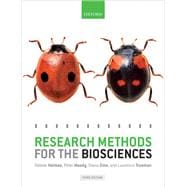Scientific research is a proven and powerful tool for discovering the answers to biological questions. As such, today's students need to be well-versed in experimental design, analysis, and the communication of research. Furthermore, they must appreciate how all of these aspects are interlinked--how, for example, statistics can be used to inform the design of a particular experiment. As a resource which skillfully integrates all of the key aspects relating to biological research, Research Methods for the Biosciences is the perfect guide for undergraduates.
The exceptionally clear layout takes students through choosing a project and planning their research; collecting, evaluating, and analyzing their data; and finally reporting their results. Research methods, which can often seem abstract, are brought to life through the use of examples taken from real undergraduate research. Friendly guidance and advice is provided throughout the text, and little prior knowledge or mathematical experience is required. Since statistics is a subject best learned through doing, frequent worked examples appear throughout Part Two 'Handling your data', showing step-by-step how to carry out the various statistical tests. In addition, online software walkthroughs and video screencasts clearly demonstrate how to use software such as SPSS, Minitab, and Excel to carry out statistical analyses.
Online Resource Centre
The Online Resource Centre to accompany Research Methods for the Biosciences features:
For students:
DT New video screencasts showing how to carry out statistical tests using software
DT Statistical software walkthroughs for SPSS, Excel, and Minitab
DT Additional statistical tests not included in the main text
DT Full details of calculations given in the in-text boxes
DT Interactive and printable decision tree, to help you design your experiment
DT Interactive and printable risk assessment form
DT Integrative exercises to help students test their understanding of the topics in the book
For lecturers:
DT A test bank of questions
DT Figures from the book available to download








